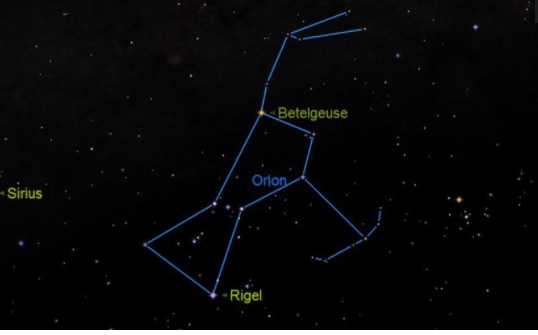Betelgeuse and Rigel: A tale of the two brightest stars in Orion

This week, the grandest and most spectacular of all constellations can be found due south and standing upright around 7 p.m. local time, and dominating our winter skies like — to use the words of astronomer Robert H, Baker — “a gigantic piece of jewelry.”
It’s the “great hunter” or “celestial warrior,” Orion, the most brilliant of the constellations and visible from every inhabited part of the Earth. As is also the case with the mighty Hercules, the figure of Orion has been associated in virtually all ancient cultures with great national heroes, warriors or demigods. Yet, in contrast to Hercules, who was credited with a detailed series of exploits, Orion seems to us a vague and shadowy figure. The ancient mythological stories of Orion are so many and so confused that it is almost impossible to choose among all of them.
Even the origin of the name Orion is obscure, though some scholars have suggested a connection with the Greek “Arion,” meaning “warrior.” All, however, agree that he was the mightiest hunter in the world, and he is always pictured in the stars with his club upraised in his right hand. Hanging from his upraised left hand is the skin of a great lion he has killed and which he is brandishing in the face of Taurus, the bull, who is charging down upon him.
Shining down upon us through the frosty air all winter long, three bright stars in a diagonal line in the middle of a bright rectangle decorate Orion’s belt, which points northward to the star clusters of the Hyades and Pleiades in Taurus, and southward to the brightest of all stars, the “Dog Star” Sirius.
Polar opposites
Within Orion we find two immense stars, Rigel and Betelgeuse, apparently at diametrically opposite periods in a star’s existence. In Rigel (the “left leg of the giant”), we find a star apparently reaching the prime of its life. It is the seventh-brightest star in our sky and is a true supergiant: a blazing blue-hot star of intense brilliance and dazzling beauty, one of the rarest breeds in our galaxy.
Located 863 light-years away, Rigel’s computed luminosity is an incredible 120,000 times the brightness of our sun. Its surface temperature is also far hotter than the sun, around 21,000 degrees Fahrenheit (11,600 degrees Celsius). Compare that to 10,000 degrees F (5,500 degrees C) for the sun. In terms of overall size, Rigel measures 79 times the diameter of the sun. And yet, it’s only 21 times more massive.
In stark contrast, Betelgeuse (the “armpit” of the giant), shines with a cool, dull ruddy hue and is located 548 light-years away, though there is an uncertainty of as much as 100 light-years with this figure. Like Rigel, Betelgeuse’s luminosity far exceeds that of our sun. It is an irregular pulsating supergiant star, nearing the end of its life and as such it expands and contracts spasmodically. Incredibly, its diameter can vary between 550 to 920 times the diameter of our sun, meaning that at its maximum size, were it placed at the center of our solar system, it would engulf the planets Mercury, Venus, Earth, Mars and Jupiter.
In trying to describe Betelgeuse some three-quarters of a century ago, Henry Neeley, a long-time lecturer at New York’s Hayden Planetarium noted that it is “like an old man with his strength almost entirely spent, panting in the asthmatic decrepitude of old age.”
An unexpected eclipse
Betelgeuse was much in the news at this time last year, because it was undergoing an unusual dimming. Because of its irregular pulsations, it was well known that Betelgeuse could appear to noticeably brighten and fade over time. But a year ago, it had diminished to magnitude +1.6. Normally the tenth-brightest star in the sky, within a matter of just a few months Betelgeuse had fallen to the rank of a second-magnitude star (if rounded off to the nearest whole magnitude).
There was much speculation that this anomalous dimming was a sign that the star might be preparing to end its life as a supernova. But by the spring of 2020, the star had once again reverted back to its “normal” brightness of magnitude +0.4. It has since faded somewhat again, though nothing to compare to the drastic fade down of a year ago.
Gesundheit!
So, what was the reason for the “Betelgeuse brownout?”
On Aug. 13, 2020, the Harvard Smithsonian Center for Astrophysics released a statement attributing the fade-down of Betelgeuse as a “stellar sneeze.” The star’s fade-down was “most likely caused by the ejection and cooling of dense hot gases, and that the star may be going through another dimming period more than a year early,” according to the statement.
The gas and dust that was blown away after the “big sneeze” eventually condensed into a dark cloud. That cloud blocked a part of the star’s face as seen from the perspective of Earth and thus caused the star to appear to dim. Some residual gas and dust may have since condensed into a smaller cloud which may be resulting in another round of apparent dimming of Betelgeuse at the present time.
Bang!
Stars produce their energy by fusing hydrogen into helium deep within their cores. When a star accumulates sufficient helium in its core, its energy output increases significantly, and it swells into a red giant or supergiant, like Betelgeuse. This is what Rigel will become in a few million years.
In such stars, the core produces successively heavier elements to balance the incessant crush of gravity. But once the core begins creating iron, a star’s days are numbered; the formation of elements heavier than iron consumes rather than produces energy. Eventually, since the core can no longer support the star’s vast weight it collapses, triggering a cataclysmic supernova explosion. Betelgeuse is in its final stage and could explode within the next 100,000 years.



 Creators of mankind
Creators of mankind Description of “Tall white aliens”
Description of “Tall white aliens” Where they came from?
Where they came from? About hostile civilizations
About hostile civilizations The war for the Earth
The war for the Earth “Tall white aliens” about eternal life
“Tall white aliens” about eternal life Video: “Nordic aliens”
Video: “Nordic aliens” Aliens
Aliens Alien encounters
Alien encounters The aliens base
The aliens base UFO
UFO Technology UFO
Technology UFO Underground civilization
Underground civilization Ancient alien artifacts
Ancient alien artifacts Military and UFO
Military and UFO Mysteries and hypotheses
Mysteries and hypotheses Scientific facts
Scientific facts


















